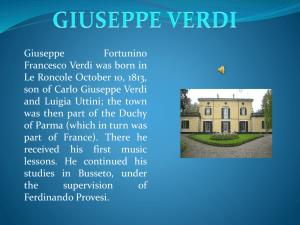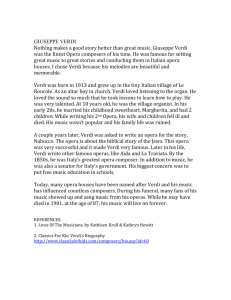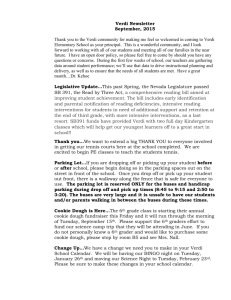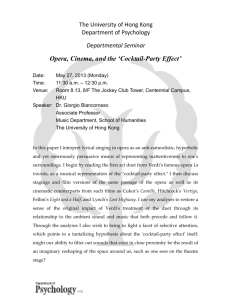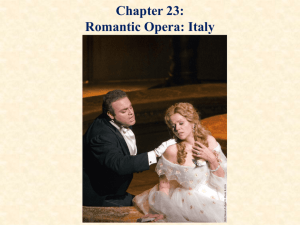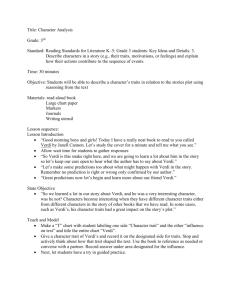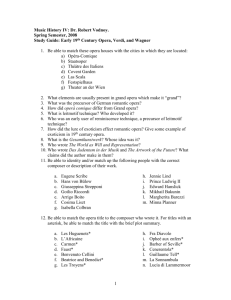VERDIAN MUSICODRAMATIC EXPRESSION IN UN BALLO IN MASCHERA A RESEARCH PAPER
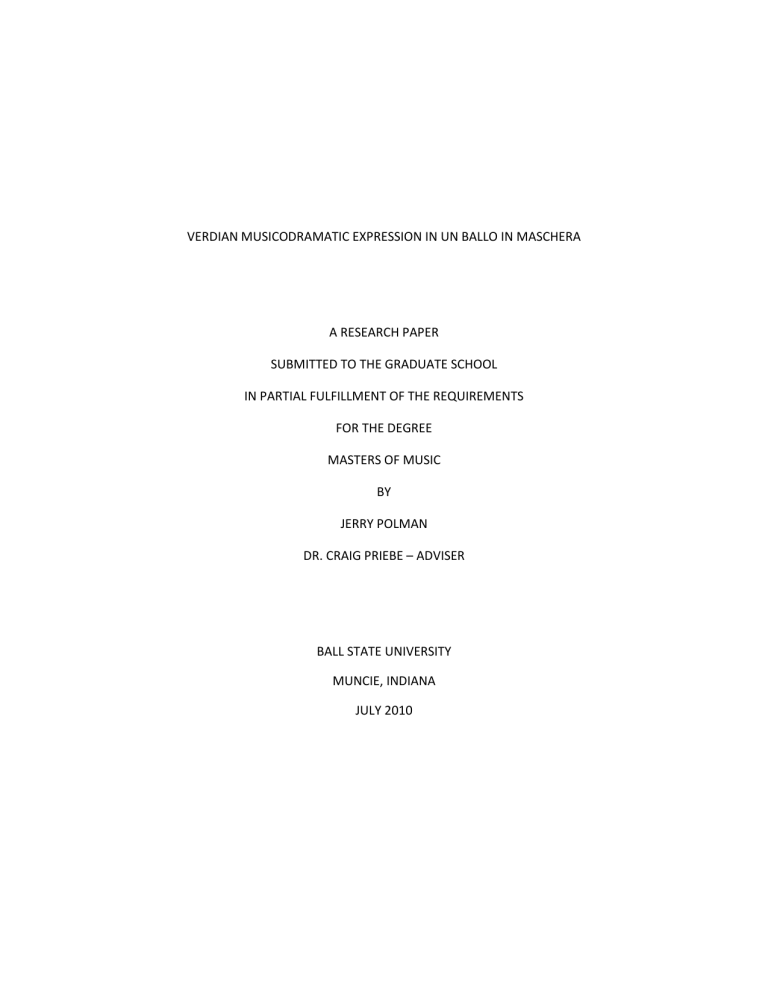
VERDIAN MUSICODRAMATIC EXPRESSION IN UN BALLO IN MASCHERA
A RESEARCH PAPER
SUBMITTED TO THE GRADUATE SCHOOL
IN PARTIAL FULFILLMENT OF THE REQUIREMENTS
FOR THE DEGREE
MASTERS OF MUSIC
BY
JERRY POLMAN
DR. CRAIG PRIEBE – ADVISER
BALL STATE UNIVERSITY
MUNCIE, INDIANA
JULY 2010
| 1
On September 19, 1857, Giuseppe Verdi wrote to the impresario at San Carlo that he was
“in despair.” He was commissioned to write an opera for the 1858 carnival season but could not find what he deemed a suitable libretto. For many years he desired to compose an opera based on Shakespeare‟s
King Lear but he deemed the singers in Naples to be inadequate for the task.
Nevertheless, he writes in the same letter that he is now “…condensing a French drama, Gustave
III di Svezia, libretto by Scribe, given at the [Paris Grand Opéra with music by Auber] about twenty years ago [1833]. It is grand and vast; it is beautiful; but this too has the conventional forms of all works for music, something which I have never liked and I now find unbearable. I repeat, I am in despair, because it is too late to find other subjects.” 1
Despite finding it
“unbearable” Verdi continued to work on
Gustave , calling on the talents of Antonia Somma to write the libretto. However, Verdi did not foresee the intense scrutiny that would be leveled against it.
Upon receiving word from Vincenzo Torelli (the impresario of the San Carlo Opera
House), that nothing less than a new production would suffice to fulfill his contract, Verdi and
Somma set to work immediately on Gustave . At this point, in order to write with greater freedom, Somma asked that his name be left off the libretto. He had already experienced some trouble with the authorities for his patriotic ideas and may have foreseen some of the problems that were to come regarding the subject of Gustave . In order to better understand this situation, let us examine, for a moment, the history of this story before it reached the hands of Verdi and
Somma.
1
William Weaver, ed. Verdi: A Documentary Study, Translated by William Weaver (London:
Thames and Hudson, 1977), 198.
In 1792, Gustave III, the king of Sweden, was assassinated by a member of his own court. The man, Ankarstrom, shot Gustave with a pistol loaded with rusty nails, thus ensuring
| 2 his eventual and painful death. Though submitted to the gravest of torture, Ankarstrom remained resolute, never giving the names of any of his possible conspirators. Fascinatingly, Gustave did pardon Ankarstrom as well as his suspected conspirators on his death-bed. Nevertheless, while his suspected conspirators were simply exiled, Ankarstrom was tortured brutally and cut into pieces in a gruesome execution.
Like the rest of modern Europe, the French poet Scribe heard of this story and decided to write a play based on the story. As an addition to the historical account, Scribe sought to explain
Ankarstrom‟s reasons for the heinous act since the man himself had provided none. For Scribe the reason would center around Ankarstrom‟s wife, Amelia. In Scribe‟s story, though she is faithful to Ankarstrom, she is pursued by Gustave and even confesses love for him. Ankarstrom, when coming to warn the king of an attempted assassination, discovers Amelia and Gustave together in the dead of night. The plot turns on this event, in which Ankarstrom goes from trusted ally to vengeful enemy.
Twice, before Verdi undertook the story, it had already been made into an opera, by
Auber in 1833 and Mercadente in 1843. The treatment by Auber, produced at the Paris Grand
Opéra quickly faded into obscurity. However, Mercadente‟s composition, though not his greatest success, did intermittently hold the stage through 1870. Mercadente‟s portrayal was first performed at the Teatro Regio in Turin. The action in his story was moved to Scotland at the time of James VI. The popularity of Mercadente‟s setting could not have escaped Verdi, but he was nevertheless drawn to the story, and its Shakespearean characters, as a substitute for Re
Lear .
| 3
Verdi and Somma‟s portrayal, entitled
Una vendetta in domino , is as follows. Gustavo, now a duke, is a carefree and light-hearted ruler. He takes pleasure in magnanimity toward his subjects and courtly splendor. Oscar, a young page boy, brings in a list of invited guests for the next day‟s masked ball. Gustavo is immediately struck by the name of Amelia, who, despite being married to Gustavo‟s secretary Ankarstrom, enamors Gustavo completely. Ankarstrom then enters bearing tidings of an assassination plot by conspirators within Gustavo‟s own court.
He is concerned about his sovereign and asks him to exercise caution, a notion which Gustavo flatly refuses. A judge then enters with a writ seeking the arrest of a local sorceress, Ulrica.
Gustavo remains ambivalent but Oscar pleads playfully for leniency citing the popularity of the woman with the peasantry. Gustavo decides that he will go in disguise to see for himself.
The next scene opens in Ulrica‟s cave where she is plying her craft in the midst of a group of commoners. Gustavo arrives early and is pleased to discover that his disguise is working as he is shuffled into a corner by the crowd. A young sailor, Silvano, then enters with a desire to know from the sorceress how he will be rewarded for his bravery in the service of
Gustavo. Ulrica predicts a commission for the young man; a prophecy which is made good by
Riccardo as he slides the paper surreptitiously into Silvano‟s coat pocket. A servant then enters asking for a private audience for his mistress, which is granted by Ulrica as everyone but
Gustavo exits the room. Gustavo remains hidden in the corner as, to his surprise, Amelia enters the room in a state of panic. She is guilt-ridden over a forbidden love for Gustavo and asks
Ulrica‟s help in removing it. The sorceress indicates that Amelia must gather an herb which grows only under the gallows in the dead of night. Amelia is terrified but resolves to accomplish the task and rid herself of her love for Gustavo; meanwhile Gustavo pledges from the shadows to be there to meet her. When Amelia leaves, the rest of Gustavo‟s party arrives and he approaches
the sorceress for a palm reading. In horror she indicates that he will die at the hand of a friend;
| 4 in fact, the very next person he shakes hands with. The conspirators, who are present in the cave, worry about being found out until Ankarstrom enters the cave and immediately takes Gustavo‟s hand. All but Ulrica laugh at the idea of the faithful Ankarstrom being Gustavo‟s assassin.
The following scene finds Amelia in the graveyard lamenting her inappropriate love for
Gustavo. In short order Gustavo himself appears and pleads for Amelia to tell him that she loves him. Eventually, Amelia submits and Gustavo revels in the confession, meanwhile expressing his love for Amelia. Suddenly a sound is heard and Ankarstrom approaches to warn Gustavo that he is being tracked by a group of conspirators determined to kill him. Amelia is veiled and, as yet, her presence is unknown to Ankarstrom. Gustavo leaves but requires Ankarstrom to escort the veiled Amelia back to the city without looking at, or speaking to her; Ankarstrom agrees. As the two prepare to leave together, the conspirators arrive and, in the confusion,
Amelia is unveiled. The conspirators laugh and deride Ankarstrom while his confusion turns to vengeance and he invites the leaders of the conspiracy to his home.
Now at home, Ankarstrom vows to kill Amelia for her infidelity despite her pleas of innocence, but eventually turns all his anger toward Gustavo. When the conspirators arrive
Ankarstrom pledges himself to the assassination plot, guaranteeing even the life of his own son if he proves unfaithful. The three argue about who will have the honor of performing the deed and it is decided that they should draw the name at random. As Amelia reenters the room,
Ankarstrom requires her to draw a name and it is shown to be his. Moments later, Oscar arrives with an invitation to the masked ball and the conspirators deem that this will be the time to carry out their plan.
The next short scene opens in Gustavo‟s office where he decides that he must do the proper thing and send Amelia and Ankarstrom away since he cannot help but love her. The
| 5 scene then opens into a ballroom where everyone in attendance is masked and in costume. After some sleuthing involving an interrogation of Oscar, Ankarstrom discovers the identity of
Gustavo. Meanwhile, Amelia begs Gustavo to flee for his life, but he will not leave her or the ball in fear. Finally, Ankarstrom fires the fatal shot and fatally wounds Gustavo, who, in his dying breath, pardons all the conspirators and pronounces Amelia‟s innocence to Ankarstrom.
A prose version of the libretto was sent to Torelli for censor approval in November of
1857. Unbeknownst to Verdi, the censors flatly refused to accept the libretto. It would be three months later when Verdi himself would travel to Naples and discover the secret Torelli had been keeping from him.
2
The censors had identified multiple issues with the libretto but Verdi focused on seven requirements that he found laughable.
1.
change the protagonist to a gentleman, removing completely the idea of a sovereign;
2.
change his wife to a sister;
3.
modify the scene of a Witch, shifting it to a period when they were believed in;
4.
no ball;
5.
the assassination off-stage;
6.
eliminate the scene of names drawn by lot;
And on, and on, and on!!...
3
2
3
Weaver 1977, 199.
Ibid
| 6
The previous list, written in a letter from Verdi to Somma in February of 1858, represented only a partial list of the demands made by the censors. Verdi was incensed by the demands and resolved not to mount the production in spite of his contract. He writes, “As you will imagine, these changes cannot be accepted; therefore, no more opera; therefore the subscribers will not pay two installments; therefore the government withdraws the subvention; therefore the
Management is suing everyone and threatens me with damages of 50,000 ducats!! …what an inferno!” 4
Despite the legal efforts mounted by the management at San Carlo, Verdi was eventually freed from his contract. The case was settled out of court with Verdi‟s lawyer Arpino citing that the changes insisted on in the libretto fundamentally altered the story, and therefore was no longer the production Verdi had promised at all. With most of the work completed, Verdi then sought a new venue for Una vendetta in domino . Somma suggested Venice or Milan where it was likely that censorship would not be an issue, but Verdi thought that he may be able to mount the production in Rome, and thereby thumb his nose at Naples on their very doorstep. He had good reason to imagine this as a possibility since the Roman censors had allowed a performance of Scribe‟s original play on the same subject only a few months prior.
5
Nevertheless, he ran into many of the same problems in Rome that he had encountered in Naples. Verdi was confused by the seeming disconnect between the allowance of the play and the problems he was experiencing with the censors. However, while plays were considered an exclusive interest of the aristocracy and cultural elite, opera was a popular entertainment of the common man and thus was subject to
4
Ibid
5
Julian Budden, The Operas of Verdi, Vol. 2. 3 vols. (New York: Oxford University Press,
1978-1981), 372.
| 7 greater scrutiny. The inflammatory aspect of the regicide as well as its geographic location and time period became the hot issues. Fortunately, in Rome, the determined impresario Jacovacci worked tirelessly on Verdi‟s behalf going back and forth with the censors until a reasonable compromise could be made.
In the end, Verdi was able to keep the aspects of the story he deemed indispensable and had to change only details that helped to make the story more remote. Most notably, the story itself was moved to pre-revolutionary Boston. This move allowed Verdi to essentially concoct a fictional society of his own making based around the pomp of the eighteenth-century French court. Some of the characters names were changed; Gustavo became Riccardo, Conte di
Warwick, and Ankarstrom became Renato, a Creole who was secretary to Riccardo. In addition, the assassination was to be allowed on stage but with a knife instead of a pistol. All of these changes were acceptable to Verdi and the production was mounted under the title Un ballo in maschera , at the Teatro Apollo on February 17, 1859. The opera was a huge success with the first night‟s audience and Verdi, though greatly relieved, was clearly spent after the ordeal. He wrote to the impresario De Sanctis, at Sant‟ Agata, in December of that year, that “After returning from Rome I have written no more music, seen no more music, thought of no more music. I don‟t even know what colour [ sic ] my last opera is and I hardly remember it. So tell
Zarlatti that I wouldn‟t know how to pick up a pen to manufacture notes, and let him think of other things…” 6
In order to understand Verdi‟s drama one need only be human, but in order to analyze his characters and the musical techniques he uses to bring them to life, one must understand Verdi, not as a composer, but as a man of the theater. Verdi himself identified his role as dramatist
6
Weaver 1977, 204.
| 8 when he was summoned to a meeting in his honor in 1893. A number of young composers gathered to honor their country‟s greatest living composer and Verdi interrupted saying “No, no, don‟t say great composer, I am a man of the theater.” 7
Throughout his career, Verdi‟s musical and theatrical revolution in Italian opera happened slowly and methodically as he gently coaxed his characters from within the accepted dramatic and musical forms. Verdi had the peculiar skill of remaining contemporary throughout his long lifetime as a composer;
8
never being relegated into obscurity by a stalwart adherence to convention and yet never departing from it far enough to be considered avant-garde. In order to equip our musical discussion of Un ballo in maschera let us take a moment to understand Verdi‟s dramatic means, including the forms and expectations he inherited and subsequently made his own.
Verdi‟s use of form and his views on it are reflected partially in the following statement aimed at music critics of his time:
The public has no business worrying about the methods an artist uses!... Nor should it have prejudices regarding style… If a performance is good, they should applaud, if it is bad, let them boo. That’s all! Music is universal. But some idiots and pedants insist on inventing schools and systems! I want the public to judge on a high level, not following the pitiful views of journalists and professional or amateur musicians, but by their own impressions. Do you understand? Impressions, impressions, nothing else.
9
While not abolishing the existing forms, Verdi‟s lack of interest in compositional doctrine freed him to seek expression over form wherever the choice had to be made. Nevertheless, Verdi‟s characters can typically be traced to the French tradition of Melodramma as adopted by the
Italian stage.
7
Gilles de Van, Verdi's Theater: Creating Drama Through Music, Translated by Gilda Roberts,
(Chicago: University of Chicago Press, 1998), 12.
8
Van 1998, 17.
9
Van 1998, 19.
| 9
Melodramma, in plays and operas of the eighteenth century is defined by characters that are essentially one-dimensional, representing great moral categories. Nuance and individuality are sacrificed in order to create archetypes that connect with the humanity of the audience at a visceral, emotional level. The aesthetics of “gesture” are an important aspect of Verdian drama.
In short, “gesture” refers to the act of making a particular meaning glaringly apparent, proclaiming both the unity of a character‟s behavior and its moral significance.
10
The “gesture” is meant to create an immediate sympathetic response from the audience that causes recognition of the archetype in question. Verdi‟s characters demonstrated this characteristic in the intense passions exhibited by each character. The deep desire to obtain the object of their desire causes
Verdi‟s characters to exhibit this one-dimensional quality; often seeking the fulfillment of their desire at the expense of their lives.
There are four melodramatic archetypes that occupy the lead roles in the majority of
Verdian drama.
11
First, and most well known, is the “hero” archetype. The hero is defined not only by love but by the mutuality of love. The other (typically male) character types we will discuss may experience love, but it will always be one-sided; spurned by the object of their affection. The hero represents freedom; freedom from law, societal convention, marital obligation, etc. He is representative of an anarchistic view of the world which seeks pleasure and the fulfillment of passion regardless of the real-world obstacles. In seventeenth- and early eighteenth-century opera the hero was typically portrayed by a castrato. By the nineteenthcentury this role is assumed almost exclusively by the tenor.
10
11
Van 1998, 93.
Van 1998, 95.
| 10
The second character archetype we must discuss is the heroine. The defining characteristic of the Verdian opera heroine is passivity.
12
The heroine is typically subject to the passions and desires of the characters surrounding her. While she may feel love for the hero, it will not be her role to initiate this love, but to respond to it. Likewise, if she is the object of desire for a tyrant (a type we will not discuss in detail), she is either crushed by his desire or saved by the hero, but never will she take a particularly active role in resolving her situation.
Since the beginning of opera, these roles have been played almost exclusively by sopranos.
The final type we will discuss in detail is the judge. The judge‟s purpose and passion is to enforce accepted law. Whether that law consists of social convention, marital rights, or any other accepted legal or moral right, it is his role to impose upon the tenor and heroine the real world demands that typically lead the story to a tragic end. The judge is typically represented by a bass or baritone voice that can communicate the gravitas of his claim. The judge may be a villainous character but it is not necessary. As in the case of Giorgio Germont in La Traviata , the judge may simply act as the voice of reason with no malice at all toward the hero or heroine.
In Ballo , the three previously mentioned character types are clearly represented with very little ambiguity. Riccardo represents the hero. In an almost childlike fashion he spurns the warnings of danger and is motivated by a singular desire to fulfill his passion for Amelia.
Amelia, the heroine, ineffectively attempts to rid herself of her love for Riccardo. Then, upon being discovered by Renato, is unable to prove her innocence to him; and finally, is unable to foil the assassination attempt despite her direct foreknowledge of it. Renato, the judge, is of particular interest and thus warrants a more lengthy discussion.
12
Van 1998, 98.
| 11
The role of the “Verdi Baritone” is most certainly the most ambiguous and complex of the characters in Verdian drama. The baritone carries the gravitas of a judge or tyrant exemplified in the bass range, but also may venture into the heroic realm of the tenor both vocally and dramatically. The role of the Italian baritone was glibly described by one commentator who said, “Italian Romantic operas are about a tenor and a soprano who want to make love and a baritone who won‟t let them.”
13
Though humorous, this description rings very true in nearly any 19 th
century Italian opera. In the case of Ballo , Renato begins the opera almost as a comprimario or second-tier character. His relationships with Amelia and Riccardo are of particular importance but his actions do little to advance the plot until the lovers are found out.
Upon discovering the lovers, Renato, despite sharing a mutual love with Riccardo and with
Amelia (as in the hero archetype), becomes a judge. His legal and cultural right to Amelia is accepted, and thus, his actions toward Riccardo are accepted as a working of fate. It is Renato, of all the characters, who undergoes the most dramatic evolution throughout the opera; from comprimario /hero to judge, with various shadings of this characterization occurring throughout the story.
It is important to note that two more of the important characters in Ballo fail to fall into any of the regular categories. This may be representative of Verdi‟s desire to expand on existing forms, but also is indicative of the French roots of the drama, which require more than the typical three main characters in Romantic Italian operatic tradition. The characters Oscar and Ulrica were of special importance to Verdi, as indicated by many correspondences concerning them. At this stage of Verdi‟s career, he was seeking ways to combine the comic and the tragic in order to balance the tinta or color of his dramas. Oscar is an expressly comic and light-hearted character
13
Van 1998, 93.
| 12 and helps therefore to balance the tragic nature of the plot and perhaps to create a feeling of irony in many scenes where he remains sunny in the midst of serious situations. Oscar is a trouser role
14
for lyric soprano and is seen by many commentators as an extension of Riccardo‟s personality into the soprano range. Ulrica is a unique character who exists on the fringes of society. The marginality of Ulrica allows her a position of immunity from the driving factors of the plot. She exists as observer and her viewpoint is therefore clearer and more penetrating than if she were also personally involved in the plot line.
15
Both Oscar and Ulrica serve as agents of destiny throughout the opera; Oscar, with grinning simplicity, and Ulrica, with grim authority.
In order to further understand all of these characters, let us go to the music of Ballo in which we may find Verdi‟s musical means of communicating the archetypes, situations, and, most importantly, the emotions of the characters under discussion. The sections of the opera I have chosen to address for the sake of time and space should provide sufficient evidence of
Verdi‟s practice of characterization.
Act I: Introduzione
The introduzione is a traditional Italian operatic convention; always occurring at the beginning of an act, in this case it serves to introduce all the main characters and the major plot points. Following an instrumental prelude, which introduces several of the important themes to be heard later, the opera begins with a hushed on-stage chorus, called a coro d’introduzione
.
This instance is typical in its simplicity, as the hushed gathering of loyal subjects sing of their love for Riccardo; however, there is more going on beneath the surface. The somber mood created by the chorus is gently interrupted in the third bar by a playful figure in the flutes and
14
A trouser role is a role specifically written in the female register, but intended to represent a male character. Often this technique is used to depict young men or boys such as our character,
Oscar.
15
Van 1998, 168-169.
| 13 oboes. (Example 1) This figure, which was first stated persistently throughout the prelude may be taken as a representation of Riccardo‟s attitude toward life and rule. The playful figure becomes lost only five bars later with the hushed fugato theme of the conspirators. This theme, which again was a major feature of the prelude, is driving, hard and unbending. (Example 2)
The intrigue of the conspirators is communicated in the insinuated complexity of a fugue. It should also be noted that the conspirators are made up entirely of bass voices, thus alluding to the Italian Romantic vocal form accepted as, among other things, villains. Many of Verdi‟s contemporaries at this point would blend the groups together melodically in order to facilitate a cohesive ensemble sound, but Verdi chooses instead to set the two distinctly separate melodies against one another and thus highlight the division within his subjects. As the coro progresses, the conspirator‟s lines, which are doubled primarily by bassoons and cellos, become a broken series of agitated sixteenth notes. All the while, Verdi uses a technique of orchestration entirely absent from any of his previous work—string harmonics, to create an ambiguous tonal quality that causes the listener to question the motives of the conspirators. (Example 3) Is it possible they have been wronged, and are deserving of revenge? The coro ends with the conspirators
„ disceso non è’
(descended [oblivion] has not), and the loyal subjects simple but heartfelt prayer for ‘l’amor’ [love] to protect the sleeping Riccardo. This coro is the first instance of many where Verdi revels in the ironic juxtaposition of two conflicting realities.
Immediately after the coro , Oscar enters and announces the entrance of Riccardo. The orchestra explodes moments later in fervor and excitement for the beloved ruler with tutti forces playing ff, a regal (and somewhat French sounding) series of short, dotted rhythms. Riccardo begins unaccompanied, „ Amici miei… Soldati… E voi del par diletti a me!
‟ (My friends…
Soldiers… And you equally dear to me!). His generosity is immediately apparent and Verdi has
given the listener every reason to like this benevolent ruler. As a continuation on this theme
| 14
Riccardo waxes eloquently about the responsibility of power and his love for his subjects while the violins laugh and frolic in arpeggios and grace notes. (Example 4) This continues, with the flutes and piccolos occasionally joining the figure, while Oscar brings Riccardo the guest list for the next day‟s masked ball. However, there is a sudden stop to the musical festivity when
Riccardo espies the name of „Amelia‟ on the guest list. Immediately the orchestra betrays his feelings by its lyricism and sensitivity expressed in long, legato lines. This is formally a recitative, but rather than stopping the musical flow, it pushes it forward into Riccardo‟s cavatina . In the cavatina we hear the love theme first introduced to the listener in the prelude.
(Example 5) Verdi structures the first half of the cavatina in typical style with four phrases of four bars each. After this, the courtiers softly comment on his emotional state though nobody knows the reason for his reverie. In the second half of the cavatina , Riccardo continues unabated and unaware of his surroundings even while the many subjects, servants, and conspirators surrounding him comment on his condition. The ensemble comes to a full stop on an F# chord and Riccardo confirms the chord in a simple command for everyone to leave the room.
As everyone leaves, the orchestra begins to play two distinct and familiar themes. First, we hear the fugato theme of the conspirators in the lower strings followed shortly by Riccardo‟s love theme in the clarinets and bassoons. Riccardo continues to revel in thoughts of Amelia while his trusted secretary Renato enters the room bearing tidings of danger for the ruler.
Unaware of his presence, Riccardo‟s love theme continues over broken statements of the fugato until he is startled to attention by Renato‟s ‘Conte…’
The quick exchange demonstrates both
Renato‟s fierce loyalty to Riccardo and Riccardo‟s fear of his love being found out by Renato.
In a bit of comedy, Renato‟s words remain sufficiently ambiguous, allowing Riccardo to believe
| 15 that the news Renato is carrying concerns his desire for Amelia. Riccardo is greatly relieved to find that it involves simply a plot on his life. Until this is revealed, Verdi demonstrates the growing tension within Riccardo with a persistent semitone tremolo in the violas and cellos. In the original Scribe play and libretto, Renato is already suspect of Riccardo‟s dealings with
Amelia, thus making this comedic moment a Verdi-Somma innovation.
16
Riccardo dismisses
Renato‟s warning saying ‘Del popol mio - l’amor mi guardi, - e mi protegga Iddio’
(Let my people‟s love keep watch over me, and let God protect me). His statement is punctuated by emphatic statements from the brass which seem to close the matter on a tutti D b chord.
By way of gentle contradiction, Renato‟s final aria is preceded by a low F in the bassoons and lower strings and is firmly in the key of B b.
Renato‟s plea for Riccardo‟s caution is accompanied frequently by the French horns and paired primarily with the woodwinds. This instrument is capable of a special kind of ambiguity since it can be used as part of the woodwind or brass family.
17
Later we will see the return of the prominent French horn as Renato sings of his planned revenge. Verdi adapts the regular cavatina form to fit his dramatic purposes by interposing a suggestive g-minor middle section in-between the two main parts in B b . Here again, the irony of the Somma libretto is highlighted by Verdi in the g-minor section as Renato asks if the love of Riccardo‟s people can always be a shield from those who would do him harm.
It will only be when Riccardo loses the love of Renato that his would-be assassins become a true threat with Renato leading them. The cavatina ends with an impassioned cadenza which soars up to a high G for the baritone. The overall effect of Renato‟s introduction does not cause one to love him as we do Riccardo but one must absolutely respect him and his love for his ruler.
16
17
Budden 1979, 380.
Ibid
| 16
The next entrance, of a judge in Riccardo‟s employ, is announced by martial sounding triplets that continue throughout the following conversation concerning the sorceress Ulrica. The judge demands swift and harsh justice but Oscar likes the sorceress for, if nothing else, the entertainment she provides. Here again, the key of contradiction seems to be B b , this time for
Oscar, against the judges D b . As Oscar asserts his desire to defend the sorceress, the martial triplets become tripping and playful. In a move perhaps suggested by Auber, Verdi sets Oscar in the traditionally French form of a couplet . Oscar‟s playful personality and ironic wit are highlighted by the character of his tripping vocal line. As Oscar suggests that Ulrica is in direct communication with Lucifer himself, he breaks into a merry laughter. (Example 6) By the time
Oscar finishes, Riccardo is sufficiently amused to desire a personal audience with the sorceress.
He summons his subjects to return and the chorus re-enters, this time with the women. The conspirators mutter and laugh at Renato‟s nervousness in short staccato phrases; Oscar and
Riccardo playfully celebrate the game to come; and the chorus eventually joins in their levity in a rousing and „Offenbachian‟ stretta d’introduzione . Riccardo‟s phrase, ‘Nell’antro dèll òracolo ‟ is set in a Gallic rhythm that suggests the practice of gallic alternative scansion. The metrical shackles of Italian completely shattered, we are now in a court, which, according to Verdi‟s desire, is very reminiscent of Louis XVI.
18
(Example 7) The chorus eventually explodes in a rousing unison with Riccardo supported by full orchestra as everyone departs to prepare for the adventure.
Act II: Scena e duetto
After the meeting with Ulrica we find Amelia in Act II beneath an empty gallows at night, searching for the herb that will cure her love for Riccardo. Unbeknownst to her, Riccardo
18
Budden 1979, 383.
| 17 has followed her to the spot and announces his entrance with the simple phrase
‘Teco io sto’
(I am with you). At Riccardo‟s entrance we move into the key of C major, the predominant key of the love duet that is the centerpiece of the opera itself.
19
This assertion has been demonstrated by
Levarie and we may discuss the reasons for a moment. The classical musical form of Ballo is supported throughout the opera by three C major pillars, only one of which we will discuss in detail, but we must, for a moment, mention the other two. In Act I, at the beginning of scene 2
Ulrica‟s invocation cavatina is first stated in c minor in the first section, then in C major in the second. It occurs in the middle of the act, it is a solo, and it serves the function of prophecy. By comparison, Riccardo‟s romanza in Act III at the beginning of scene 2 moves from c minor to C major. It occurs in the middle of the act, it is a solo, and it serves to reminisce about his encounter with Amelia. Directly in the center of Act II we find the love duet, in the key of C major as the fulfillment of Ulrica‟s prophecy. The rest of the drama hangs over these three essential musical and dramatic pillars. Now that its importance should be well-established, let us look in some detail at this unique Verdi love duet.
The beginning of the duet is standard, with short exclamatory exchanges from both singers, anticipated by agitated strings, and punctuated by short instrumental statements. Amelia consistently tries to distance herself from Riccardo but her true feelings and his dogged persistence prevent her escape from the situation. In a traditional Rossinian tripartite duet, the key factor is the contrast between the movements.
20
A dialogue will be contrasted with a joint soliloquy or vice-versa. However, in this case, the second movement is a continuing evolution of the first, with Riccardo slowly breaking down Amelia‟s resistance. This section closes with a
19
Siegmund Levarie, "Key Relations in Verdi's Un Ballo in Maschera," 19th-Century Music 2, no. 2 (November 1978), 145.
20
Budden 1979, 399.
move to an A-major chord which sets up Amelia‟s hushed confession of
‘Ebben, si, t’amo…’
| 18
(Very well, yes, I love you). After Riccardo confirms Amelia‟s confession, the couple moves into the important key of C major where they will remain through the rest of the duet. Riccardo then builds up to the cabaletta with an impassioned recitative renouncing all other fealty but love, which is followed by descending sixteenth-note patterns in the strings that seem to indicate his descent into an oblivious love for Amelia. The bright cabaletta then begins with the conspicuous entrance of the harp, an instrument used only on rare occasion in Ballo and usually to indicate a volatile emotional situation. The cabaletta is a distinct and memorable melody reminiscent of Donizetti in its tunefulness and yet much more poignant in its emotional effect.
The breakdown of Amelia‟s resistance to Riccardo is seen as she takes on the same melody, even though her words continue to protest against any expression of their love. At the conclusion of the first section of the cabaletta , Riccardo once again asks Amelia for a confession of her love.
This time, the response from the tutti orchestra playing ff is one of the most emotionally gripping musical moments in all of Verdian opera. The tempo slows dramatically and the sense of a physical/visceral response from the couple is unmistakable. One cannot help but see this as the musical consummation of their love. Immediately thereafter, the couple returns to the cabaletta material together with Amelia‟s vocal line increasingly resembling Riccardo‟s in its passion and intensity. In spite of her continued verbal protests, Amelia‟s overpowering love for Riccardo is given away musically by the orchestra and by her own musical line. This love duet, often described as Verdi‟s only love duet written for two „grown-ups‟, is perhaps also the most satisfying in the breadth and depth of its musical expression of passionate response between two lovers.
Act III: Scena ed aria: Eri tu
The final section we will examine is perhaps the most frequently performed as a stand-
| 19 alone performance piece. Upon discovering his wife together with Riccardo, the previously faithful Renato burns with hatred and vengeance. He has threatened to kill Amelia but she has deftly pleaded for her life on behalf of her son. Renato sends her out of the room and begins the scena portion of his composite aria in the key of e b minor as the oboes and clarinets play a variation on Riccardo‟s love theme from the first act. An interesting reminiscence occurs on
Renato‟s words, ‘Nell’ombra e nel silenzio’
sung to a pattern from his first act warning to
Riccardo. (Example 8) The memory of a love for Amelia causes Renato to change his mind and direct his vengeance toward Riccardo in the new key of E-major. Yet another change occurs as
Renato discusses the stabbing of Riccardo with an unstable b-minor supported by restless violins and violas playing their tumultuous sixteenth-note figure from the prelude. Finally, the key settles firmly into d minor with Renato‟s last statement of „ Vendicator.’
The sudden martial rhythm adopted by the orchestra lends power and resolve to Renato‟s decision. The beginning of his melody on „a‟ is a foreshadowing of Verdi‟s technique throughout the aria. Verdi sets up a feeling of expectation on the part of the listener by holding close to the dominant throughout the aria. There is very little repetition throughout the aria suggesting a real-time unfolding of ideas on the part of Renato. For the first portion of the aria
Renato focuses on the betrayal of his friend Riccardo as he is accompanied by the martial rhythms heretofore mentioned but at the midpoint his desire for violence changes to a lament on the loss of love. At this poignant emotional moment, we again see the entrance of the judiciously utilized harp, followed by another melody that is somewhat reminiscent of
Riccardo‟s love theme. The flutes and harp take a leading role until the conspicuous and jarring
| 20 entrance of the French horns. Here we may again allude to the ambiguous timbre of this instrument as a mirror of the Verdi baritone‟s ability to act as a dynamic character within
Verdian drama. After the statement of the French horns, the harp again takes the fore with an increasingly agitated rhythm that climaxes in intensity all the way up to the end of the aria and
Renato ends, not with violence, but with a heart-breaking lament on the meaninglessness of his love for Amelia in the key of F-major.
In all of these examples, Verdi may be seen as a Romantic dramatist working within conventional Bel canto musical forms. Verdi, of all operatic composers, found a way to maintain lyricism and unity while still expressing truth in emotion and action on the stage. Verdi‟s innovation came slowly and methodically but it is no less dramatic over his lifetime than that of
Wagner. His advances in Ballo represent a new stage in the maturation of his orchestral style as well. Far more than simply an accompanying force, the orchestra communicates the inner desires and emotions felt by the characters and even draws ironic connections across events.
Some critics have leveled the accusation that Ballo is reminiscent of operetta in the simplicity and forwardness of its characters which fails to recognize Verdi‟s immersion into melodramatic forms. Auber or even Mercadente may be accused of over-simplifying the story musically but
Verdi, through the sheer power and emotional impact of his music, must remain exempt from all such criticism. His Ballo is an enduring masterpiece that has stood the test of time and will reward the returning listener over and over again with new delights at the combination of irony, comedy, tragedy, and raw, human emotion.
| 21
Bibliography
Baldini, Gabriele, Fedele D'Amico, and Roger Parker. The Story of Giuseppe Verdi: Oberto to Un ballo in maschera.
Translated by Roger Parker. Cambridge: Cambridge University Press, 1980.
Bianconi, Lorenzo, and Giorgio Pestelli. Opera in Theory and Practice, Image and Myth.
Translated by
Kenneth Chalmers and Mary Whittall. Chicago: University of Chicago Press, 2003.
Budden, Julian. The Master Musicians: Verdi.
Edited by Stanley Sadie. London & Melbourne: J.M. Dent
& Sons, Ltd., 1985.
———. The Operas of Verdi.
Vol. 2. 3 vols. New York: Oxford University Press, 1978-1981.
Dent, Edward J. "Un Ballo in Maschera." Music & Letters 33, no. 2 (April 1952): 101-110.
Giger, Andreas. "Social Control and the Censorship of Giuseppe Verdi's Operas in Rome (1844-1859)."
Cambridge Opera Journal 11, no. 3 (November 1999): 233-265.
Godefroy, Vincent. The Dramatic Genius of Verdi: Studies of Selected Operas.
Vol. 2. 2 vols. London:
Victor Gollancz Ltd., 1977.
Levarie, Siegmund. "Key Relations in Verdi's Un Ballo in Maschera." 19th-Century Music 2, no. 2
(November 1978): 143-147.
Martin, George Whitney. Aspects of Verdi.
New York: Dodd, Mead & Company, 1988.
———.
Verdi: His Music, Life and Times.
New York: Dodd, Mead & Company, 1963.
Parker, Roger, and Matthew Brown. "Motivic and Tonal Interaction in Verdi's "Un ballo in maschera"."
Journal of the American Musicological Society 36, no. 2 (Summer 1983): 243-265.
Peyser, Herbert F. "Un Ballo in Maschera." In Introduction to Opera , edited by Mary Ellis Peltz, 8-15.
New York: Barnes & Noble, Inc., 1956.
Phillips-Matz, Mary Jane. Verdi: A Biography.
New York: Oxford University Press, 1993.
Senici, Emanuele. "'Teco io sto': Strategies of Seduction in Act II of "Un ballo in maschera"." Cambridge
Opera Journal 14 (2001): 79-92.
Van, Gilles de. Verdi's Theater: Creating Drama Through Music.
Translated by Gilda Roberts. Chicago:
University of Chicago Press, 1998.
Weaver, William, ed. Seven Verdi Librettos.
Translated by William Weaver. New York: W. W. Norton &
Company, Inc., 1975.
———, ed.
Verdi: A Documentary Study.
Translated by William Weaver. London: Thames and Hudson,
1977.
Example 1, Giuseppe Verdi, Un ballo in maschera , “coro d‟introduzione,” m. 3
| 22
Example 2, Giuseppe Verdi, Un ballo in maschera, “coro d‟introduzione,” mm. 9-11
Example 3, Giuseppe Verdi,
Un ballo in maschera, “ coro d‟introduzione,” mm. 14-16
| 23
Example 4, Giuseppe Verdi, Un ballo in maschera, “Porgete a me,” mm. 28-40
Example 5, Giuseppe Verdi, Un ballo in maschera , “Prelude,” mm. 27-30
Example 6, Giuseppe Verdi, Un ballo in maschera, “Volte la terrea,” mm. 272-279
| 24
| 25
Example 7, Giuseppe Verdi, Un ballo in maschera, “stretta d‟introduzione,” mm. 477-485
Example 8a, Giuseppe Verdi, Un ballo in maschera , “Alla vita che t‟arride, recit.,” mm. 62-65
Example 8b, Giuseppe Verdi, Un ballo in maschera, “Eri Tu,” mm. 3-4
| 26

